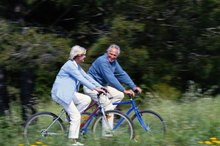What does fact checked mean?
At Healthfully, we strive to deliver objective content that is accurate and up-to-date. Our team periodically reviews articles in order to ensure content quality. The sources cited below consist of evidence from peer-reviewed journals, prominent medical organizations, academic associations, and government data.
- Harvard Health Publications: Calories Burned in 30 minutes for People of Three Different Weights
- ACE Fitness: Ready to Run?
The information contained on this site is for informational purposes only, and should not be used as a substitute for the advice of a professional health care provider. Please check with the appropriate physician regarding health questions and concerns. Although we strive to deliver accurate and up-to-date information, no guarantee to that effect is made.
Facts About Jogging
If you don’t have the time or money for gym memberships and exercises classes, you can still boost your health and get fit by jogging, which is simply running at an easy pace. According to the National Sporting Goods Association, jogging was one of the fastest growing sports from 2009 to 2010, with the number of people participating in the sport increasing by 10 percent.
Build Strong Bones
Unlike swimming and biking, jogging can make your bones stronger. The National Osteoporosis Foundation recommends 30 minutes of weight-bearing exercise, such as jogging, a day to help prevent osteoporosis.
Burn Calories
Three Exercises That Lower Blood Pressure
Learn More
Most people burn nearly 600 calories an hour jogging. According to Harvard Medical School, a 155 pound person jogging at a pace of 12 minutes per mile burns 298 calories every 30 minutes. That’s more calories than you’ll burn in the same amount of time dancing, doing aerobics, lifting weights or swimming.
- Most people burn nearly 600 calories an hour jogging.
- According to Harvard Medical School, a 155 pound person jogging at a pace of 12 minutes per mile burns 298 calories every 30 minutes.
Live Longer
A Copenhagen City Heart Study released in 2012 found regular jogging increases the life expectancy by 6.2 years for men and 5.6 years for women 2. To reap the maximum benefits of jogging, the study recommends jogging for 60 to 150 minutes per week at an easy to moderate pace. You should be running at a pace easy enough to talk, which makes jogging something you can do with a friend.
Fight the Flu
What Effects Does Dancing Have on the Human Body?
Learn More
Your ability to fight the flu may increase if you’re a jogger. In a 2008 study involving three groups of mice, mice who jogged 20 to 30 minutes per day were better able to fight the flu virus than either sedentary mice or mice who’d run vigorously. (See reference 4) The scientists who conducted the study believe this is because moderate exercise, such as jogging, helps the body produce immune cells needed to fight infections. (See reference 4)
- Your ability to fight the flu may increase if you’re a jogger.
- See reference 4) The scientists who conducted the study believe this is because moderate exercise, such as jogging, helps the body produce immune cells needed to fight infections.
- (
Exercise on Your Schedule
Jogging is one of the simplest forms of exercise. All you need is comfortable clothing and a good pair of running shoes. You don’t need to drive to the gym or spend a lot of money on gear. You can squeeze your jog in before work or on your lunch hour. You can even turn your workout into a social hour and jog with friends after work. You’ll skip the empty calories you’d consume at happy hour and get your workout done.
- Jogging is one of the simplest forms of exercise.
- You can even turn your workout into a social hour and jog with friends after work.
Tips to Jog By
Check with your doctor before starting any new exercise routine, especially if you have any recent injuries. You can avoid some injuries and pain just by jogging in shoes made specifically for running.
Related Articles
References
- Harvard Health Publications: Calories Burned in 30 minutes for People of Three Different Weights
- The Independent: Jogging ‘Increases Life Expectancy’
- New York Times: Phys Ed: Does Exercise Boost Immunity?
- ACE Fitness: Ready to Run?
- Press Release. 2015 Stravia Insights Show Cycling and Running Landscape in the U.S. Outdoor Industry Association. Published online, January 2016.
- Williams PT. Relationship of running intensity to hypertension, hypercholesterolemia, and diabetes. Med Sci Sports Exerc. 2008;40(10):1740-8. doi:10.1249/MSS.0b013e31817b8ed1
- Williams P. T. (2008). Relationship of running intensity to hypertension, hypercholesterolemia, and diabetes. Medicine and science in sports and exercise, 40(10), 1740–1748. doi:10.1249/MSS.0b013e31817b8ed1
Writer Bio
Lisa Thompson has been writing since 2008, when she began writing for the Prevention website. She is a holistic health practitioner, nationally certified massage therapist and National Council on Strength and Fitness-certified personal trainer. Thompson also holds certificates in nutrition and herbology from the Natural Healing Institute, as well as a Master of Education from California State University.







